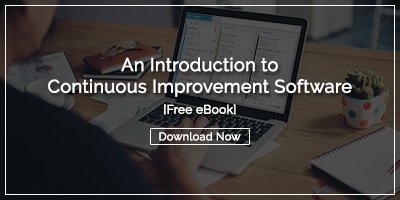 Organizations striving to reach operational excellence through continuous improvement engage in many individual projects to achieve this goal. However, the most successful organizations implement a structured approach for managing their improvement work so that every person in the organization can contribute to positive change.
Organizations striving to reach operational excellence through continuous improvement engage in many individual projects to achieve this goal. However, the most successful organizations implement a structured approach for managing their improvement work so that every person in the organization can contribute to positive change.
Specialized continuous improvement project management software helps organizations dedicated to CI get the most out of each project. Dedication to structured change will give your team a leg up on the competition and help it reach its most important strategic goals faster and more efficiently.
Visibility
One significant challenge to keeping improvement projects organized is visibility into what work is done across the organization. Unfortunately, spreadsheets and email are notoriously poor methods for tracking improvement activities.
Improvement software provides real-time visibility into what is happening on the front lines. This matters because:
Leaders Can React Quickly
A chief responsibility of leaders is removing obstacles that block the way forward for improvement work. This isn't possible without visibility into the daily activities of each group they manage. Visualizing improvement projects in a central platform is the best way to make it possible for leaders to respond proactively to roadblocks and stalled progress.
Increased Engagement
Ideally, every employee will be involved in improvement projects of some kind. But this sort of engagement is tough to achieve if the ideas of quality management and continuous improvement are theoretical and vague. Providing data about progress toward critical goals with easy-to-understand chargers and graphs helps people feel more connected to the activities that make up business success. Additionally, when people see their work's impact on the KPIs, they grow emotionally invested in the results.
More Effective Meetings
Visual management of improvement projects allows leaders to shift the purpose of meetings from updates and recaps to problem-solving and strategic planning. Because everything is visualized, the areas that need discussion are immediately apparent so that the conversation can begin with the most important subjects. When meetings are focused this way, people are more likely to see them as helpful and good use of their time.
Collaboration
Collaboration happens naturally within teams or business functions with little or no management intervention. Collaboration between different departments or processes is a much more significant challenge, but that's where it can have the most impact.
That's why organizations choose a project management solution for continuous improvement that makes it possible for everyone to work together to achieve the most significant impact. With the right solution in place, organizations can:
Accelerate Innovation
Every person sees processes and outcomes from their perspective, so how one person approaches a problem can be very different than how another sees it. Uniting people from multiple areas of the organization can offer new ideas to approach the most challenging issues. As a bonus, having numerous people engage in an improvement project often leads to results that are satisfactory to everyone.
Complete Projects More Quickly
Without visibility and structure, collaboration can slow projects down. But with improvement software in place, all the information, documents, and visual tools are available to everyone, no matter which department they are in. This approach helps take the friction out of collaboration and ensure that forward progress is fast.
Facilitate Learning
Collaborating with people who are subject experts in other areas of the organization is an excellent way to spread knowledge and information. Collaboration also helps everyone better understand how their work fits into the big picture and the strategy. For example, having a training manager who understands the hiring process could be a big advantage. Another benefit is that knowing more about the rest of the organization may encourage employees to expand their ideas about their career paths.
Continuous Improvement Software Features
With this understanding of the benefits of continuous improvement software, let's look at the specific features that help keep your CI projects organized.
Opportunity Capture
Before beginning an improvement project, you must know that an opportunity exists. With CI software, any employee can suggest an improvement or document a problem that needs attention. Ideally, employees can suggest improvements at any time on the device of their choice. They should be able to include any documents, images, or other digital files that help support the need for change or explain their suggestion.
Engagement Reports
It is the responsibility of leaders to make sure that a culture of continuous improvement is thriving in the organization. Improvement project management software gives them insight into the people, teams, functions, and locations contributing ideas and managing projects to completion. This knowledge facilitates coaching disengaged employees and recognizing those on the right track.
Strategy Alignment
Improvement work shouldn't happen in a vacuum. Instead, projects should be initiated when they can help move toward the annual or long-term goals of the organization. Part of keeping projects organized is knowing which objective they are related to. CI software helps achieve this by allowing strategic goals to cascade from the top level to individual employees. One specific tool used for this purpose is the X-matrix, which is available in the best CI solutions./X-Matrix/X-Matrix.png?width=656&name=X-Matrix.png)
Roll-Based Views and Boards
Each person will have unique needs for keeping their CI projects organized. That's why it is essential to look for continuous improvement software that allows users to configure boards that work for them. For example, executives may have multiple boards that show projects across locations and functions, while front-line employees have a simpler view. In addition, boards can be used to facilitate daily huddle meetings, manage Kanban, or display key metrics on a wall.
Notifications and Alerts
One of the reasons that dedicated improvement software makes managing projects so much more effective than email and spreadsheets is the ability to set up proactive notifications and alerts. With smart, custom notifications, people get exactly the information they need when they need it. For example, supervisors know when a new improvement opportunity has been suggested, or a due date has passed without activity. You can even set up a daily digest to ensure that nothing falls through the cracks.
Searchable Knowledge
Continuous improvement is a knowledge-building endeavor, but much of that knowledge can be lost when employees leave the organization or change roles unless it is captured in a central repository. CI software becomes just that, allowing team members to search past projects to see what has worked well (or not) for others. Each improvement project benefits from what has already been learned.
Impact Reporting and Success Broadcasting
People are more likely to engage in improvement work when they understand its impact on the key objectives and strategic direction, "Keeping score" is an excellent way to increase the enthusiasm of front-line employees and executives alike. It is the best way to secure investment in improvement projects that require capital. Another benefit of tracking impact is that it makes it easier for managers to recognize and reward a job well done. Finally, broadcasting improvement enhances the culture and motivates folks to keep up the excellent work.
Whether your improvement work is structured under a methodology such as Lean or Six Sigma or you engage in it independently, CI software will help keep your team on track, prove the effectiveness of the work, and make each project more effective. Look for a solution designed specifically with improvement work in mind and a provider with the resources and experience to help you achieve a successful and widely adopted implementation.



Add a Comment